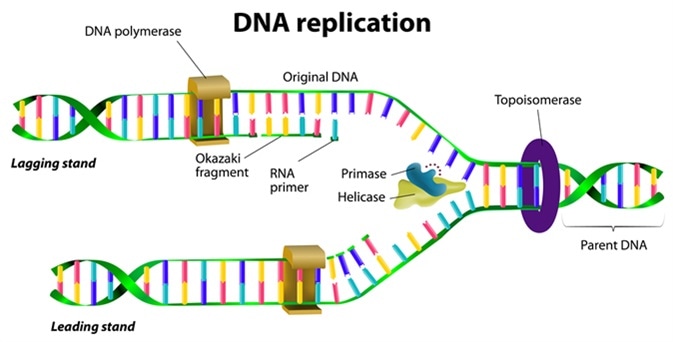MECHANISM OF DNA REPLICATION, ZOOLOGY STUDENTS
MECANISM OF DNA REPLICATION
-Dna replication occurs in the s-phase of inerphase of cell cycle due to which the amount of dna is dooble.
-Replication of dna is a complex multistep process with each sky precisely controlled by a specific enzyme.many protein factor and ions are required for replication.
ORIGIN OF REPLICATION;-
-The origin of replication or ori is of a particular region of dna having a specific sequence of nucleo tides called autonomic replicating sequence.
-Prokaryotic dna has a single replicon while eukaryotic dna has hundreds and thousnds of replicons.
-Repucation proceeds on both sides from the ori site which is called bidirection replication.
ACTIONVATION OF NULEOTIDES;-
-The four types of deoxyribonucleotides required for dna replication are DEMP,DGMP,DTMP and DCMP.
-These nucleotictes added phosphoric acid with the help of energy and phosphorylase to produce triphosphate state and water.
UNWINDING OF HELIX:-
-Unwinding of dna helix at the ori site is brought about by the enzyme “HELICASE” called also rep protein which unzips the two strands of dna .
-The separate stands are stabilized in this condition with the help of single strand binding protein.
-Unwinding creates tension which is by enzyme topoisomerase I and II .
-Tropoisomerase II of prokaryotes is also know as dna
gynase.
-Unzipping of dna molecule created a Y-shaped replication fork.
RNA PRIMING:-
-Due to replication fork , two different ends of the two strands of dna are exposed I,e ‘3’ end ‘5’ end .
-At the free 3’ end of one stand and at the fork of the second strand a small RNA, called RNA PRIMER is synthesized with the help of the enzyme primase.
FORMATION OF NEW STRAND:-
-The two separted strands of dna now functions as templates.
-Their nitrogenous bases attocict comple mentany phophory lated nucleotides from each phosphrylated nucleotides , two making them as monophosphates with the release of energy that is used in building hydrogen bonds between the base pairs and also formation of covalent bonds between the new bases.
- The newly paired successive nucleodies are joind by phosphodiepter linkages with the help of the enzyme dna polymerase, also known as replicase.
-The enzymes add nucleotides only at 3’ end of the strand ,so that new dna formation occuri in 5’ -> 3’ directon .
ELONGATION OF NEW STRAND :-
-Dna replication proceds , the parent stands unzipper further to expose new regions for chain elongation.
-The new strand grows towards the fork in the 5’ -> 3’ direction it is known as leading strand.
-This new strand builk of okazaki fragments is called laggingstrand, because it takes lenger times to develop.
-As replication is continuous over one strand and discontinuous over the other; hence it is called semi-continuous or semi –discontinuous.
TERMINATION;-
-Termination of DNA occurs in termination sites , known
as ter sites.
-Termination requires product of tus gene which recognized ter sites.
-At the ter sites ter blinding proteins (TBP) bind and stops the progress of replication fork.
-In the leading strand replication is terminated at sites where as in the lagging strand it is stopped 50-100 bp before the ter site.
PROOF READING AND DNA
REPAIR:-
-Though the process of DNA replication is very accurate still a wrong nucleotide gets incorpornted in the new strand very runely.
-Every DNA polymenase III is unable to disting wish uracil from thymine. About one final error may occur in every one billion (109) base pairs replicated.



Comments
Post a Comment